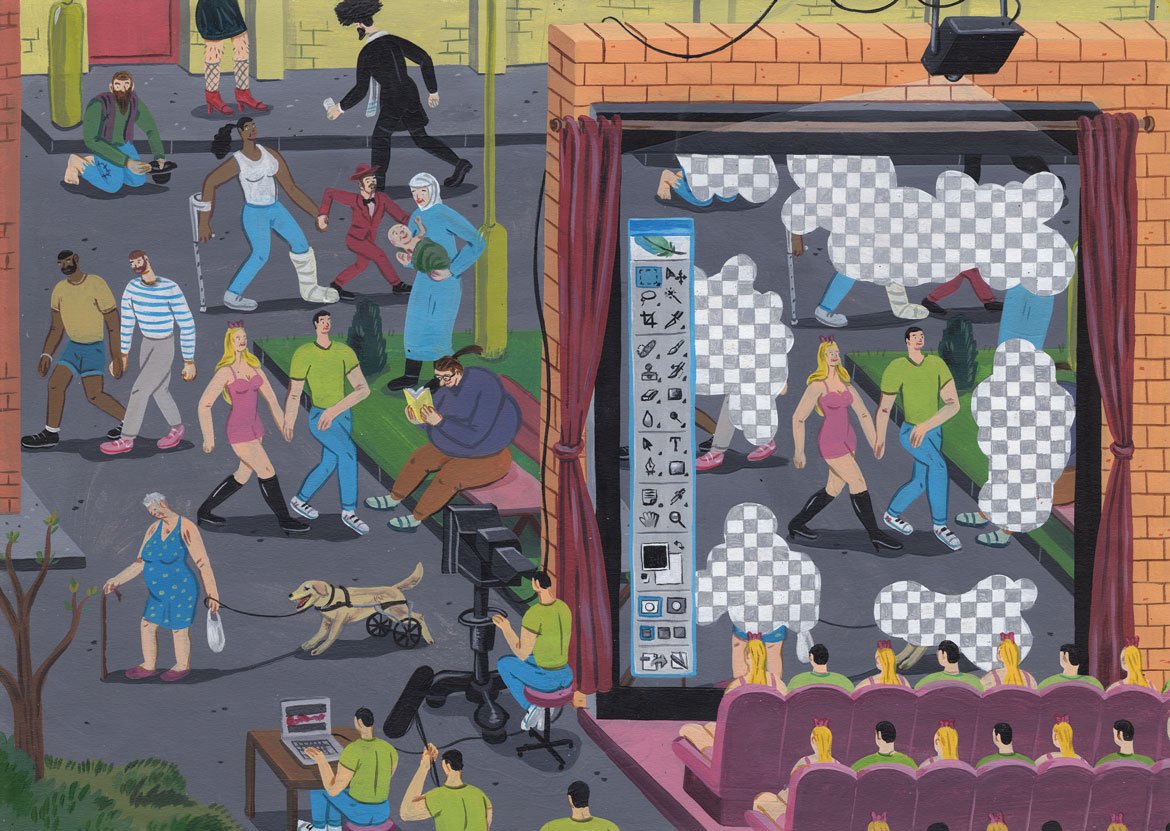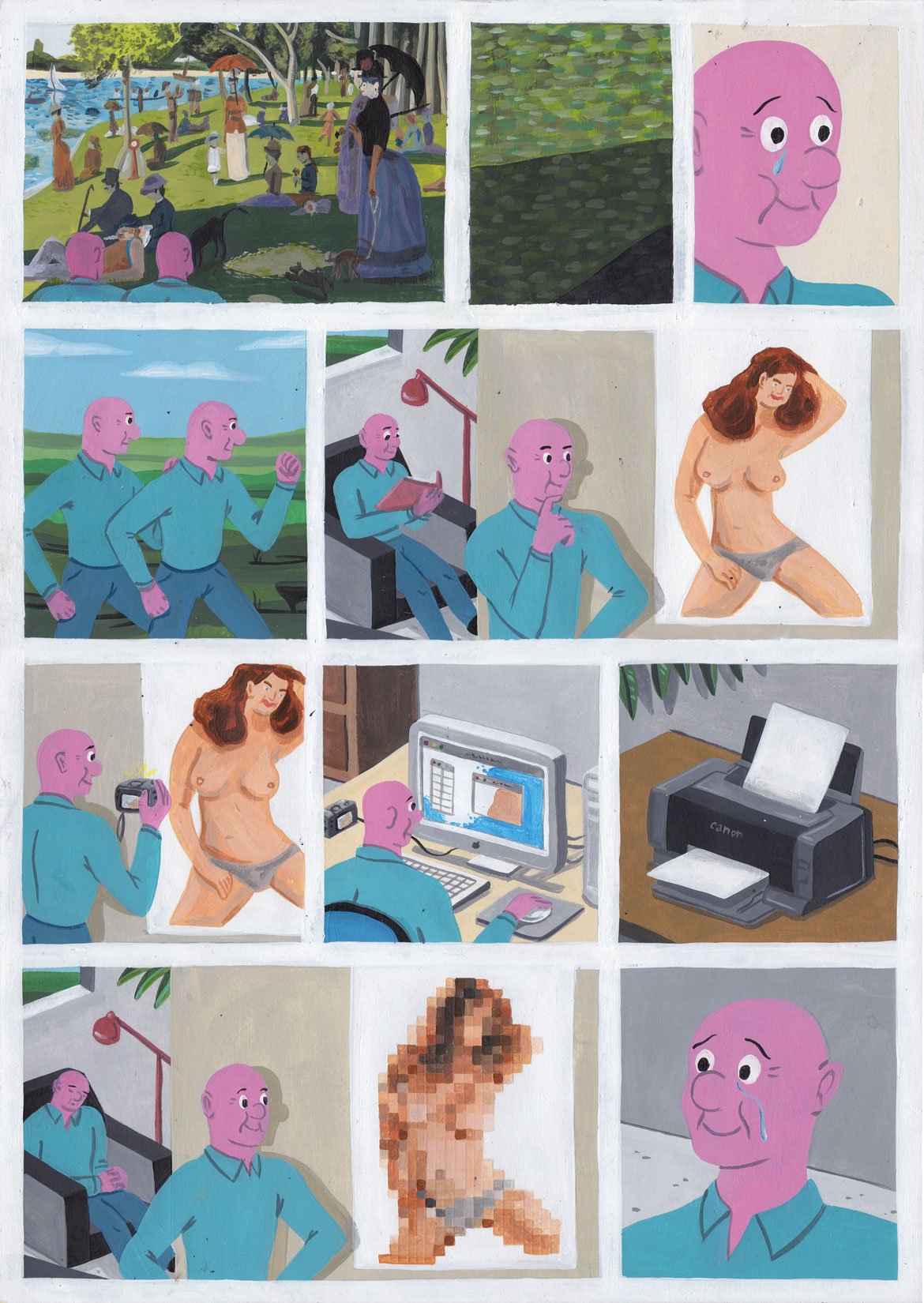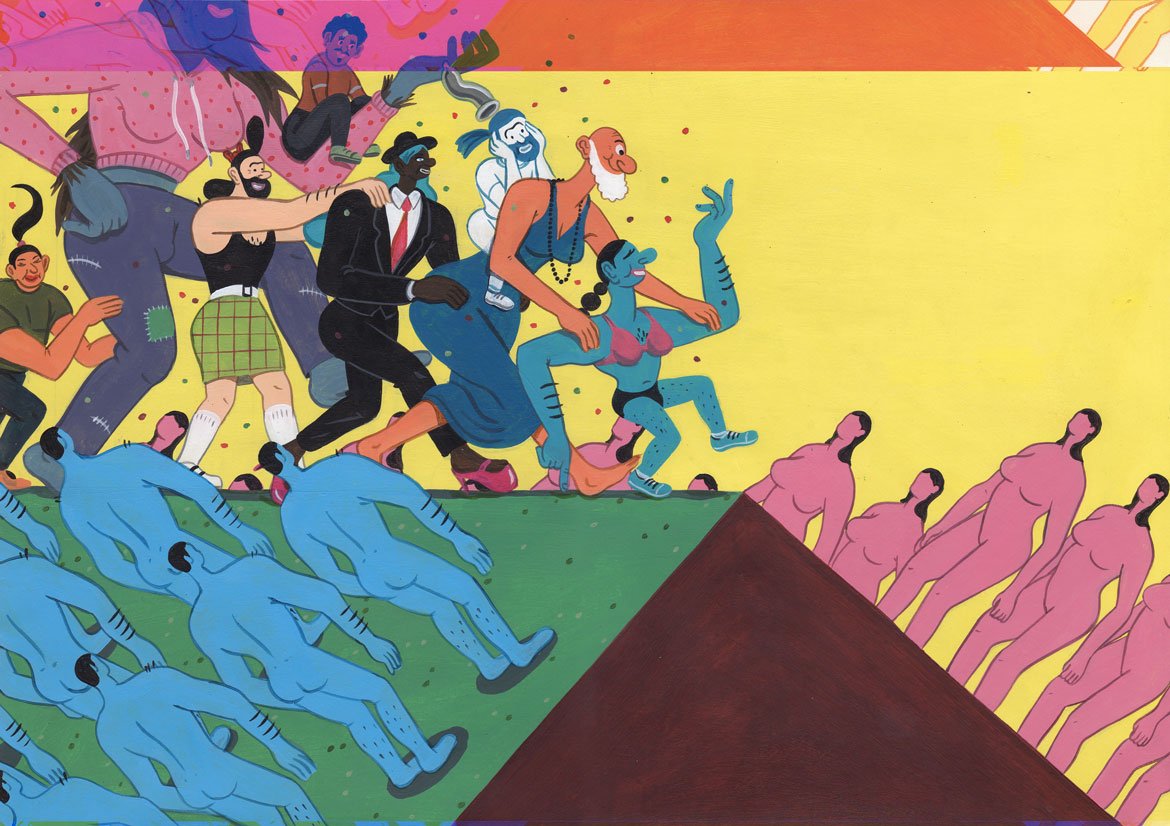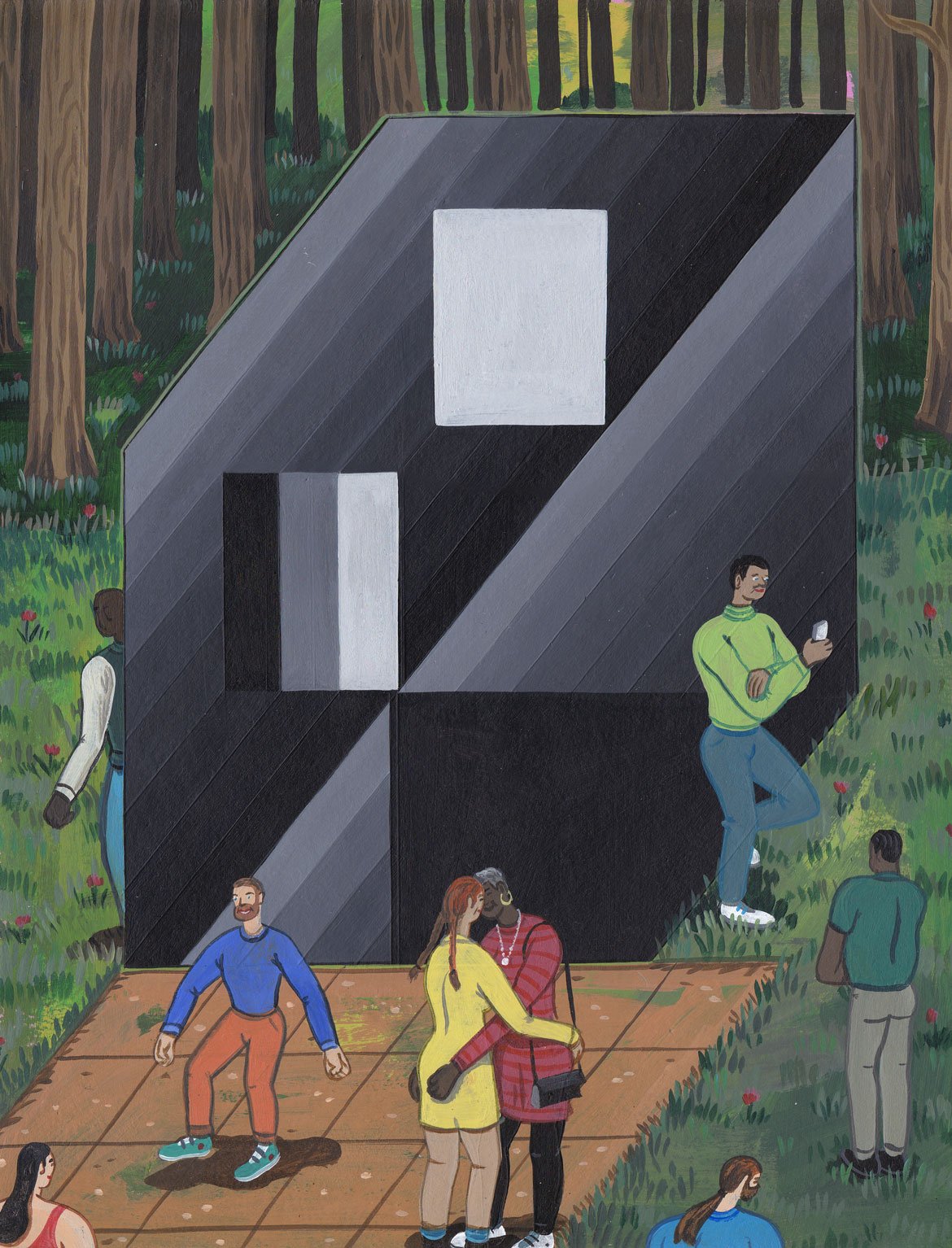Brecht Vandenbroucke
Interview by Tali Ramsey
Brecht Vandenbroucke is a Belgian painter who utilises the world that surrounds him as his muse, emphasising on the compelling parts of human nature and the system that we live in. His intelligent and unique creations alternate between comical and darker contexts by focusing on themes of work, social class and sexuality.
One of his stand out works ‘White Cube’, is inspired by the contemporary London art gallery of the same name and satires how people react to art through two pink faced characters who comically navigate their way around the art scene.
Do you think that it’s important to open up a dialogue about art and exclusivity through your paintings?
I don’t know if it’s important but I can see how people will read into that from seeing my work. Asking questions about the world and life is one of my main motivations. It’s like playing, like a kid. But instead of with blocks, I try to do it with codes and rules and visuals. I never really think about what I want to make actually, mostly it just comes. I don’t have a big plan. All I know is that I don’t want to have fear in my life. I try to throw up concepts and ideas to understand them better, to look at them from a different angle. But I don’t have any solutions. I want to show people that it’s okay to think for themselves, that they don’t need to hide behind anyone else’s ideas.
This theme of highlighting elitism also seems to be present in your piece ‘Selection’ which denotes an almost lottery system when it comes to getting an education. What was your inspiration behind the piece?
Well, that piece specifically was an illustration for a Belgian newspaper. I sometimes illustrate and the piece was based on an article about how there is less money for education and there are more people studying than ever, which means the selection will be harder and stricter. Education is very important. A part of succeeding is where you come from, what your background is. It also depends on self-esteem, determination, and a lot of luck. Life is chaos and very arbitrary I guess. So that’s why I presented it as kind of a crane game, with the professor deciding.
Do you think that art is an important part of society?
Yes. I think that they are inseparable, if not the same. It is all about culture: It’s how artists play and interact with existing codes and ideas, and remix them again and again to make something new. I think that is beneficial to everyone and the way we communicate. For me, art redefines the human condition: how we see ourselves and what it means to be human today. We do this by searching for the limits of what we think is right and wrong and pushing them, confronting them and in that way reshaping our norms and values. It is searching for new horizons, different perspectives and angles to look at ourselves and/or the universe through. Art can be a great way to diversify our view on society.
“For me, art redefines the human condition: how we see ourselves and what it means to be human today.”
Have you ever personally felt excluded from the art world?
No, because I never aimed to be part of it or any other kind of group.
I make my own thing, I select the places and people that interest me (as everyone does I guess) and follow those. So it’s very individual. It’s the luxury of this time. There are so many amazing galleries, publishers and places to choose from, sometimes it’s even a bit overwhelming.
All the different streams and different local scenes, I find fascinating to see. I think it’s a good thing. But I never felt part of one group or movement, I like to look around and try out things. I’m never really committed to one thing or direction. I guess I just like a lot of very different things. People can also be very serious about art and what it should be and some would never even consider what I do as art. That’s fine. I know what I would like to see, so I try to make that. For example, to me humour is very important and if I don’t find it at one place, I’ll go looking for it somewhere else.
I guess what I am trying to say is that I’m not expecting anything from anyone.
Your works ‘Part Timer’ and ‘The Work is Never Done’ seem to centre on the intensity of the work system that we live in, would you say that this is true?
‘Part Timer’ was an illustration for an article about how we run through life and work and then need to take a break to find our balance back, and how more young people are realising that only working is not the right goal for them in life. ‘The Work is Never Done’ on the other hand, is about how people build walls between each other while other people are doing their best to break them down. It’s a never ending cycle. It’s about staying alert and determined to not give into the fear. In the end everyone is doing her or his best. It sounds sentimental in ironic times but I think in the end everyone is looking for love and respect in some way.
What are your experiences navigating the work place? Would you say that your works are self-depictions or based off of observations?
I try to observe but in the end my work will always be subjective. I have a limited perspective from my own experiences but I try to stay curious and listen to other views. My work is never about me in the way that I would never draw myself. I don’t think that I’m that interesting. But It is a personal view on a world that feels very un-personal to all of us. The least I can hope for is to make a connection and make someone feel something. And because of that maybe in the end make us both feel like we’re not alone. I play a lot with surrealism but sometimes it’s enough to just depict a situation to highlight the absurdness of daily life. Nothing is crazier than reality.
Do you think that your work is humorous or depicts a more serious and darker side of society?
I try to have them both. For me emotions are very close to each other. Something that is very scary can be very funny and the other way around. They go hand in hand, it’s ying and yang. I am interested in both, life is complex and I am not one emotion. I don’t have a ‘style’ where everything has been laid out for the years to come. I just try to move along with the way the universe changes, and my perception on it. But humour is extremely important to me, yes. It’s the best way to show that nothing really is THAT important. Everything in life is relative. Most of what I do is satire. And I can understand that not everyone gets that. I hear people always talking about how far can you go with humour. My question to them is how far can you go with seriousness. Life’s a cabaret!
“Peoples bodies in real life are all unique and who decides what’s masculine or feminine looking? ”
Your cartoonist characters sometimes look sexualised, is this accidental or is there a point behind it, is there a sexual element to your work?
I think they are ‘sexy by accident’. That would be a good title, can I use that for my autobiography? But I can see how, the bodies and men I draw can be very energetic and there is a sensuality sometimes. I also drew some characters in restriction gear or tied up. But for me it’s more of a direct way to show power and the way we treat each other, so it’s not always about sex in an obvious way. But then again, sometimes it is. I guess it’s a good thing and it is part of life. But I’m definitely no Tom of Finland, I think I’m not serious enough for that. It’s mostly comical when people are sexy in my work. It’s also funny, because drawings are not the first thing people think of when they think of ‘sexy’. I think drawing lost the competition with photography a long long time ago when it comes to sexiness. So I would never try to attempt to draw ‘sex’ in a serious way.
You also appear to play with gender when it comes to drawing your characters, has this anything to do with your own opinion on gender identity and the fluidity between masculinity and femininity?
In my free time, that is definitely something that I’ve been trying out for the past years in my work. I want to draw all kinds of bodies. I got a bit bored by drawing the idea of ’men’ and ‘women’ and it came to me after I started experimenting with silhouettes. It’s fascinating to see how quickly a character can turn from male to female, or something in between. I’m not just talking about adding a bow in a drawing of Mickey and Minnie mouse. Sometimes it’s just by changing the shoulders, hairs or curves you get a whole different reading of a character. Bigger hands, wider hips, a longer, more elegant neck.
It’s weird to see how we read such small changes as either male or female. I still draw men and women too by the way, because sometimes you just need that easy direct way of communicating what they are, depending on the subject of the drawing. But it’s interesting to play with and break that mold. Peoples bodies in real life are all unique and who decides what’s masculine or feminine looking? I’m still researching it and how to add this to my ‘drawing vocabulary’, there’s a lot of possibilities there. I hope to someday draw characters where you really can’t tell what gender they are.
I think confusion is good, it challenges people to think.
In the future, what other societal themes do you think you’ll find inspiration in and focus on?
I’m writing a lot right now and because I am interested in everything, there’s inspiration everywhere. But I don’t know where it’s going, times are rough so I try to spend less and less time online. I am a little concerned about how free the internet will stay, there’s already a lot of censorship and that’s the worst thing for art. So I’m very focused on love right now. I think it’s the hardest societal theme to tackle in an non ironic way. I just wish I could make a drawing as beautiful and poetic as Jean-Jacques Sempé did on his book cover of ‘sentiment Distingues’. That’s my next goal.
















